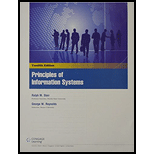
PRINCIPLES OF INFO.SYS.(LL)>CUSTOM PKG<
12th Edition
ISBN: 9781337074674
Author: STAIR
Publisher: CENGAGE C
expand_more
expand_more
format_list_bulleted
Concept explainers
Question
Chapter 10, Problem 1WE
Program Plan Intro
- An information system is a system which provides the necessary information to an organization to achieve the goals.
- It monitors the transactions details, provides the required information to decision makers, and provides necessary documents to customers.
- The main components in the information system are people, data, procedures, hardware, as well as software.
- The main function of information system is to accept and process the input data and then stores the retrieved information and distributes it across the organization.
Importance of auditing:
- Auditing involves analyzing of financial condition for an organization.
- It determines whether financial statements and reports produced by financial MIS are accurate.
- The sound auditing procedures are required.
- It can reveal potential fraud.
- It can reveal false or misleading information.
Example of audit:
The financial statements such as income statements and balance sheets are been used by many people as well as organizations. The sound auditing procedures are been required in this case.
Expert Solution & Answer
Want to see the full answer?
Check out a sample textbook solution
Students have asked these similar questions
Create a relationship between the common field (Technician Number) of the two tables. Make sure that each client must have 1 and only 1 technician assigned, and each technician can have multiple clients.
2. Create a query to show the Client Number, Client Name, Billed, Paid for clients in Anderson city. Save the query.
3. Create a query to show the Technician Number, Last Name, First Name, YTD Earnings for technicians whose Hourly Rate is greater than or equal to 30. Save the query.
4. Create a query to show Client Number, Client Name, Billed, Paid for clients whose technician number is 22 and whose Billed is over 300. Save the query.
5. Create a query to show the Technician Number, Last Name, First Name, Client Number, Client Name for clients whose technician number 23. Save the query.
6. Create a query to show the Technician Number, Last Name, First Name, Client Number, Client Name for clients whose technician number 23 or 29. Save the query Help please Microsoft office access
Dijkstra's Algorithm (part 1). Consider the network shown below, and Dijkstra’s link-state algorithm. Here, we are interested in computing the least cost path from node E (note: the start node here is E) to all other nodes using Dijkstra's algorithm. Using the algorithm statement used in the textbook and its visual representation, complete the "Step 0" row in the table below showing the link state algorithm’s execution by matching the table entries (i), (ii), (iii), and (iv) with their values. Write down your final [correct] answer, as you‘ll need it for the next question.
4. |z + 5 - 5i| = 7
Chapter 10 Solutions
PRINCIPLES OF INFO.SYS.(LL)>CUSTOM PKG<
Ch. 10.6 - Prob. 1DQCh. 10.6 - Prob. 2DQCh. 10.6 - Prob. 1CTQCh. 10.6 - Prob. 2CTQCh. 10.9 - Prob. 1DQCh. 10.9 - Prob. 2DQCh. 10.9 - Prob. 1CTQCh. 10.9 - Prob. 2CTQCh. 10 - During which stage of the problem-solving process...Ch. 10 - The three stages of decision making are augmented...
Ch. 10 - Prob. 3SATCh. 10 - Prob. 4SATCh. 10 - Prob. 5SATCh. 10 - Prob. 6SATCh. 10 - Prob. 7SATCh. 10 - Prob. 8SATCh. 10 - Prob. 9SATCh. 10 - Prob. 10SATCh. 10 - Prob. 11SATCh. 10 - The ______ approach is a structured, interactive,...Ch. 10 - Prob. 13SATCh. 10 - Prob. 14SATCh. 10 - Prob. 1RQCh. 10 - Prob. 2RQCh. 10 - Prob. 3RQCh. 10 - Prob. 4RQCh. 10 - Prob. 5RQCh. 10 - Prob. 6RQCh. 10 - Prob. 7RQCh. 10 - Prob. 8RQCh. 10 - Prob. 9RQCh. 10 - Prob. 10RQCh. 10 - Prob. 11RQCh. 10 - Prob. 12RQCh. 10 - Prob. 13RQCh. 10 - Prob. 14RQCh. 10 - Prob. 15RQCh. 10 - Prob. 16RQCh. 10 - Prob. 17RQCh. 10 - Prob. 1DQCh. 10 - Prob. 2DQCh. 10 - Prob. 3DQCh. 10 - Prob. 4DQCh. 10 - Prob. 5DQCh. 10 - Prob. 6DQCh. 10 - Prob. 7DQCh. 10 - Prob. 8DQCh. 10 - Prob. 9DQCh. 10 - Prob. 10DQCh. 10 - Prob. 1PSECh. 10 - Prob. 1TACh. 10 - Prob. 2TACh. 10 - Prob. 3TACh. 10 - Prob. 1WECh. 10 - Prob. 2WECh. 10 - Prob. 3WECh. 10 - Prob. 1CECh. 10 - Prob. 2CECh. 10 - Prob. 1DQ1Ch. 10 - Prob. 2DQ1Ch. 10 - Prob. 1CTQ1Ch. 10 - Prob. 2CTQ1Ch. 10 - Prob. 1DQ2Ch. 10 - Prob. 2DQ2Ch. 10 - Prob. 1CTQ2Ch. 10 - Prob. 2CTQ2Ch. 10 - Prob. 1DQ3Ch. 10 - Prob. 2DQ3Ch. 10 - Prob. 1CTQ3Ch. 10 - Prob. 2CTQ3
Knowledge Booster
Learn more about
Need a deep-dive on the concept behind this application? Look no further. Learn more about this topic, computer-science and related others by exploring similar questions and additional content below.Similar questions
arrow_back_ios
SEE MORE QUESTIONS
arrow_forward_ios
Recommended textbooks for you
 Fundamentals of Information SystemsComputer ScienceISBN:9781305082168Author:Ralph Stair, George ReynoldsPublisher:Cengage Learning
Fundamentals of Information SystemsComputer ScienceISBN:9781305082168Author:Ralph Stair, George ReynoldsPublisher:Cengage Learning Principles of Information Systems (MindTap Course...Computer ScienceISBN:9781285867168Author:Ralph Stair, George ReynoldsPublisher:Cengage Learning
Principles of Information Systems (MindTap Course...Computer ScienceISBN:9781285867168Author:Ralph Stair, George ReynoldsPublisher:Cengage Learning Information Technology Project ManagementComputer ScienceISBN:9781337101356Author:Kathy SchwalbePublisher:Cengage Learning
Information Technology Project ManagementComputer ScienceISBN:9781337101356Author:Kathy SchwalbePublisher:Cengage Learning Principles of Information Systems (MindTap Course...Computer ScienceISBN:9781305971776Author:Ralph Stair, George ReynoldsPublisher:Cengage Learning
Principles of Information Systems (MindTap Course...Computer ScienceISBN:9781305971776Author:Ralph Stair, George ReynoldsPublisher:Cengage Learning Management Of Information SecurityComputer ScienceISBN:9781337405713Author:WHITMAN, Michael.Publisher:Cengage Learning,
Management Of Information SecurityComputer ScienceISBN:9781337405713Author:WHITMAN, Michael.Publisher:Cengage Learning,

Fundamentals of Information Systems
Computer Science
ISBN:9781305082168
Author:Ralph Stair, George Reynolds
Publisher:Cengage Learning

Principles of Information Systems (MindTap Course...
Computer Science
ISBN:9781285867168
Author:Ralph Stair, George Reynolds
Publisher:Cengage Learning


Information Technology Project Management
Computer Science
ISBN:9781337101356
Author:Kathy Schwalbe
Publisher:Cengage Learning

Principles of Information Systems (MindTap Course...
Computer Science
ISBN:9781305971776
Author:Ralph Stair, George Reynolds
Publisher:Cengage Learning

Management Of Information Security
Computer Science
ISBN:9781337405713
Author:WHITMAN, Michael.
Publisher:Cengage Learning,